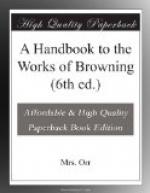“A LIKENESS” describes the feelings which are inspired by the familiar or indifferent handling of any object sacred to our own mind. They are illustrated by the idea of a print or picture, bought for the sake of a resemblance; and which may be hanging against a wall, or stowed away in a portfolio: and, in either case, provoke comment, contemptuous or admiring, which will cause a secret and angry pain to its possessor.
“APPEARANCES,” a little poem in two stanzas, illustrates the power of association. Its contents can only be given in its own words.
“ST. MARTIN’S SUMMER” represents a lover, with his beloved, striving to elude the memory of a former attachment, and finding himself cheated by it. As the fires of a departed summer will glow once more, in the countenance of the wintry year, so also has his past life projected itself into the present, assuming its features as a mask. And when the ghosts, from whom, figuratively, the young pair are hiding, rise from their moss-grown graves; and the lover would disregard their remonstrant procession as only “faint march-music in the air”: he becomes suddenly conscious that the past has withdrawn its gifts, and that the mere mask of love remains to him.
The poem would seem intended to deny that a second love can be genuine: were not its light tone and fantastic circumstance incompatible with serious intention.
PROLOGUE TO “LA SAISIAZ,” reprinted as “Pisgah-Sights,” III., is a fantastic little vision of the body and the soul, as disengaged from each other by death: the soul wandering at will through the realms of air; the body consigned to the
“Ferns
of all feather,
Mosses and
heather,” (vol. xiv. p. 156.)
of its native earth.
Second Group.
“CAVALIER TUNES” consists of three songs, with chorus, full of rousing enthusiasm for the cause of King Charles, and of contemptuous defiance for the Roundheads who are opposing him: I. “Marching Along.” II. “Give a Rouse.” III. “Boot and Saddle.”
“HOW THEY BROUGHT THE GOOD NEWS FROM GHENT TO AIX” is an imaginary picture, which would gain nothing in force by being true. It is that of three horsemen galloping to save the life of their town; galloping without rest, from moonset to sunrise, from sunrise into the blaze of noon; one horse dropping dead on the way, the second, within sight of the goal; and the third, Roland, urged on by frantic exertions on his rider’s part—the blood filling his nostrils, and starting in red circles round his eyes—galloping into the market-place of Aix; to rest there with his head between his master’s knees: while the last measure of wine which the city contains is being poured down his throat.
“SONG” is a lover’s assertion of his lady’s transcendent charms, which he challenges those even to deny who do not love her.




